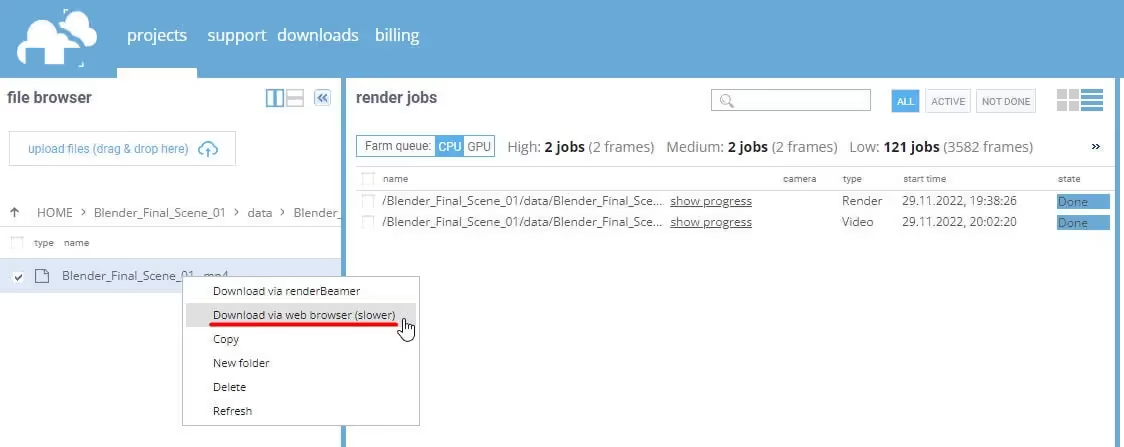We all know that it is not recommended to render directly to a video format because of potential issues that may occur during rendering which might make the video file unusable.
GarageFarm gives you an ability to create a video based on a rendered sequence of frames. In other words, you can convert the previously rendered frames of PNGs or JPEGs to a video format such as MP4.
To convert a sequence of images to a video we use the FFmpeg tool. It allows us to render videos using our cloud technology quickly and without the need of having any additional video editing programs.
You can create video output from a rendered sequence of images in two ways - manual and automatic.
Any time you have finished rendering a job in an image format i.e. PNGs or JPEGs, you can then manually select those files or a finished job and convert them to a video using a so-called “video job”.
To manually add a job that converts sequence of images to video output, follow any of the three options:



After executing the "Create video sequence" option, a job submission window will appear where you can see and configure all video encoding related settings (more on that in point 3 of this guide).
You can create video output automatically every time you add a render job to the queue.
In the standard render job submission window for Blender, 3ds Max, and After Effects, you’ll find a checkbox “create video sequence from output frames” which enables additional settings for rendering videos.

Basically, this option works just like executing the "create video sequence" option we covered earlier (the manual way). The difference is that this video job is added automatically as a separate job along with the scene you are about to render so in effect you will have 2 jobs. As soon as the render job is finished and all the frames are rendered, the conversion will be performed on the sequence from the given job.
To use this feature, all you have to do is check the “create video sequence from output frames” box in the job settings window and choose your preferred video output settings.
In this section, we’ll cover all the video related settings that are available in the video job.
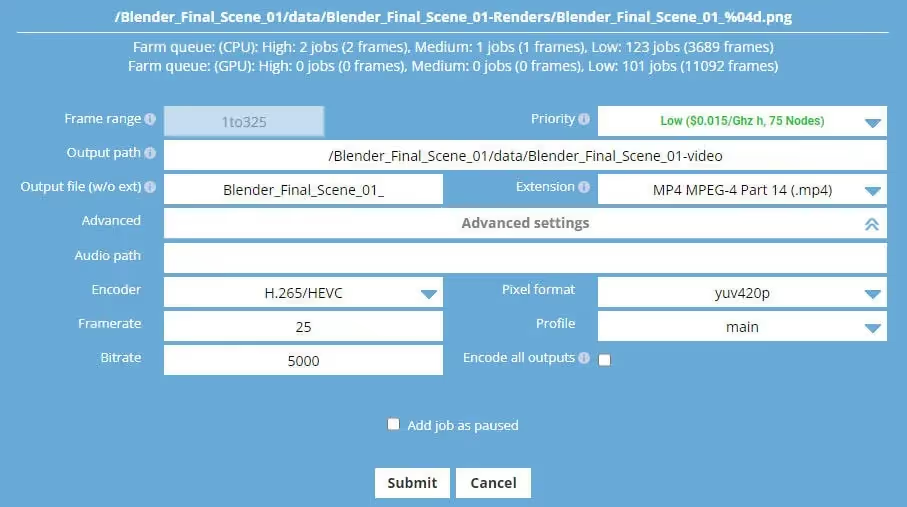
Frame range - the range is set automatically based on the detected image sequence you want to convert to video output. If you tick on the “create video sequence from output frames” option when adding a job to the queue, this range will be the same as the range for the rendering job. Then, after completing the rendering of all the frames from that sequence, the job that converts frames to video will start.
Priority - before adding a job to the render queue, you can decide how you want to prioritize it. Depending on the queue and farm traffic, a higher priority may allow your job to quickly acquire nodes to convert your sequence of images faster. Each priority has a different rate - a detailed list can be found here: https://garagefarm.net/pricing
Output path - here you can find the default save path for converted video in the given job. The default output path is based on the name of your project and scene/sequence images. You can edit this path if you clone your job and need to render a different extension in that project.
Output file (w/o ext) - by default, the frames file name is set based on the name of your sequence images. If you want to create a unique name and/or you need to customize naming for the output according to your pipeline, you can set your own name for the output video file.
Extension - by default, the video output extension is set to a common setup, which is .mp4 (MP4 MPEG-4 Part 14). However, if you want to change the extension to a different one, you can choose from the available options, i.e: .mkv, mov, .webm, mxf

Advanced settings
Audio path - here you can add a path for your audio that you want to be included for video output. If you uploaded (in advance) your .mp3; .wav or .ogg audio file, put the path to it, e.g.: /_add_GF/final_audio.mp3

Encoder - depending on the video output extension you choose, you can select one of the specific codecs:

Framerate - that means frames per second, also known as FPS option. It is the frequency (rate) at which consecutive images (frames) are displayed in one second of video. By default it is set to 25, but you can also set any other value for FPS, eg: 24, 30, etc.
Bitrate - by default, the value of this parameter is set to 5000. This is a well known standard and gives good quality video output. Nevertheless, if you prefer to set a higher value, feel free to change it.
Pixel format - by default, it is set to "yov420p" depending on your preferences, you can choose one of the available Pixel formats:
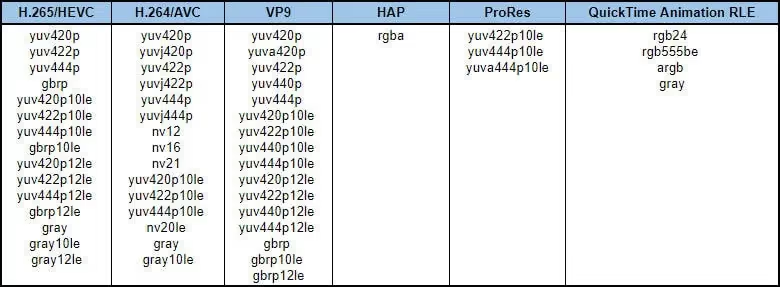
Profiles - By default it is set to "main profile". Depending on which encoder for video output you choose, there you can select one of the specific profiles:
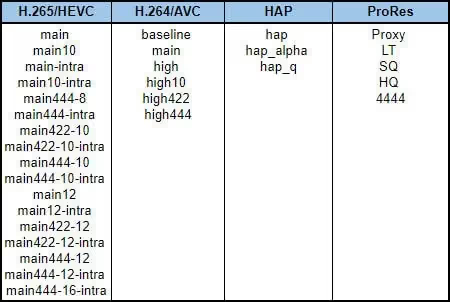
Encode all outputs - this option is useful when you have render elements in your scene and you would like to convert each of them to a separate video file. By default this option is disabled, so only the main render output frames (or a selected sequence) will be used to create a video by default. If enabled, all rendered layers will be used to convert them to video output.
Add job as paused - if you tick this option and then submit your job, it will be added with the status “paused”. This means that it will not start rendering automatically. It is useful to use this option if you intend to add the job to the queue, but you do not intend to render it at the moment. After adding a "paused" job, you can resume it at any time by selecting the "resume job" option (right-click on the job).
Submit - when you press this button, the system will immediately add the job to the render queue. Please remember to check all settings before submitting a job!
Cancel - if you do not want to add the current job to the render queue or you want to reset your settings and add the scene again, you can use this option. The submission window with the settings for the given job will be closed and all changes will be cancelled.
Both the rendered frames and the video output can be downloaded in a standard and automatic way via the renderBeamer app.
Each rendered and completed output is downloaded automatically to your local drive to a directory you selected in the renderBeamer application. If you’re unsure where your download folder is located, you can double-check it or change it in renderBeamer’s settings (click on the cogwheel). Also, ensure you have auto download turned on to get the frames downloaded as soon as they are available. If this box is unchecked, you will have to click on each job in Beamer's "downloads'' tab, and manually download the output(s).
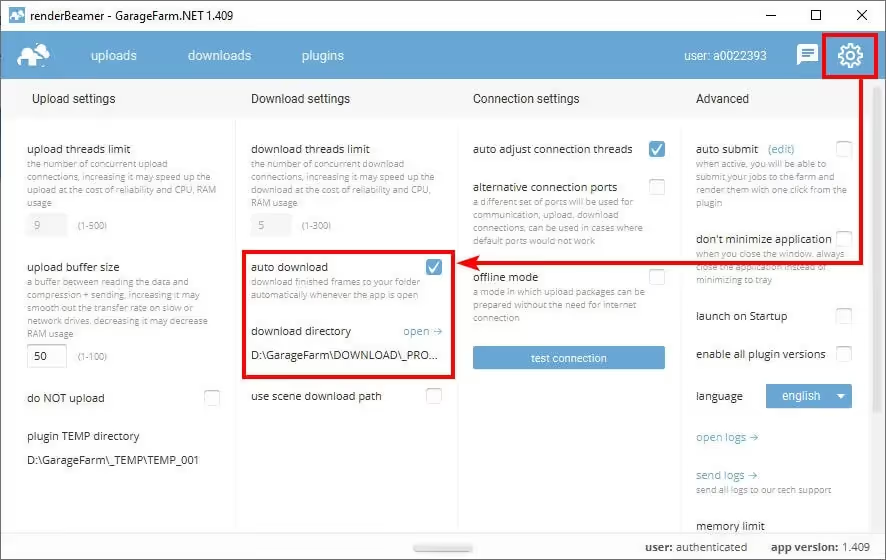
If you prefer more control over what to download and when, you can also download your output(s) manually. To do that, just turn off the auto download switch in renderBeamer settings and go to the “downloads” tab. Next, select the desired render output using a checkbox, and click the download button.
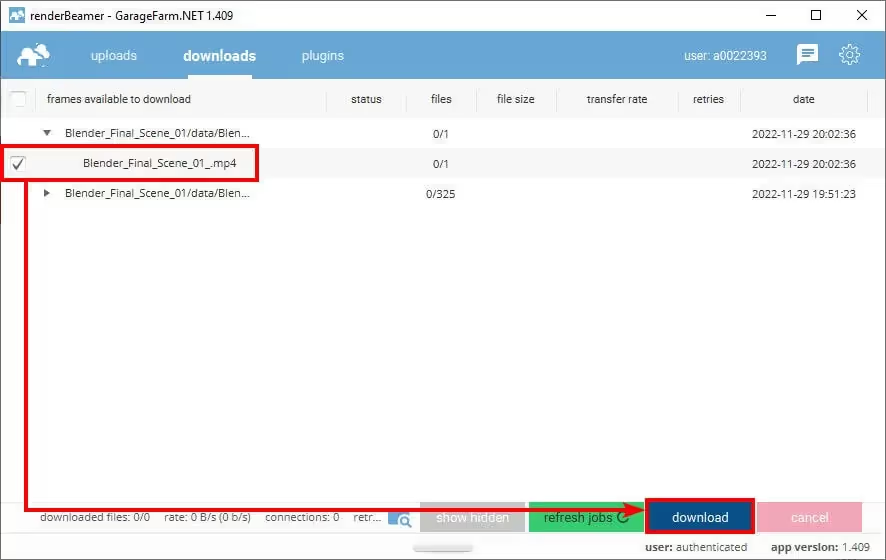
The other option is to download directly from the web dashboard. To download an output, click RMB on a video file you’d like to download and select the option: “Download via web browser”. This way you do not need to open our application to download a file because it will be downloaded using the browser.
